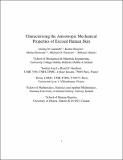| dc.contributor.author | Ní Annaidh, Aisling | |
| dc.contributor.author | Destrade, Michel | |
| dc.contributor.author | Gilchrist, Michael D. | |
| dc.date.accessioned | 2013-02-14T10:21:08Z | |
| dc.date.available | 2013-02-14T10:21:08Z | |
| dc.date.issued | 2012 | |
| dc.identifier.citation | Annaidh, AN,Bruyere, K,Destrade, M,Gilchrist, MD,Ottenio, M (2012) 'Characterising the anisotropic mechanical properties of excised human skin'. Journal Of The Mechanical Behavior Of Biomedical Materials, 5 :139-148. | en_US |
| dc.identifier.issn | 1751-6161 | |
| dc.identifier.uri | http://hdl.handle.net/10379/3235 | |
| dc.description.abstract | The mechanical properties of skin are important for a number of applications including surgery, dermatology, impact biomechanics and forensic science. In this study, we have investigated the influence of location and orientation on the deformation characteristics of 56 samples of excised human skin. Uniaxial tensile tests were carried out at a strain rate of 0.012 s(-1) on skin from the back. Digital Image Correlation was used for 2D strain measurement and a histological examination of the dermis was also performed. The mean ultimate tensile strength (UTS) was 21.6 +/- 8.4 MPa, the mean failure strain 54% +/- 17%, the mean initial slope 1.18 +/- 0.88 MPa, the mean elastic modulus 83.3 +/- 34.9 MPa and the mean strain energy was 3.6 +/- 1.6 MJ/m(3). A multivariate analysis of variance has shown that these mechanical properties of skin are dependent upon the orientation of the Langer lines (P<0.0001- P=0.046). The location of specimens on the back was also found to have a significant effect on the UTS (P =0.0002), the elastic modulus (P=0.001) and the strain energy (P=0.0052). The histological investigation concluded that there is a definite correlation between the orientation of Langer Lines and the preferred orientation of collagen fibres in the dermis (P<0.001). The data obtained in this study will provide essential information for those wishing to model the skin using a structural constitutive model. | en_US |
| dc.description.sponsorship | Marie Curie Fellowship | en_US |
| dc.format | application/pdf | en_US |
| dc.language.iso | en | en_US |
| dc.relation.ispartof | Journal Of The Mechanical Behavior Of Biomedical Materials | en |
| dc.rights | Attribution-NonCommercial-NoDerivs 3.0 Ireland | |
| dc.rights.uri | https://creativecommons.org/licenses/by-nc-nd/3.0/ie/ | |
| dc.subject | Soft tissue | en_US |
| dc.subject | Langer lines | en_US |
| dc.subject | Tensile properties | en_US |
| dc.subject | Histology | en_US |
| dc.title | Characterising the anisotropic mechanical properties of excised human skin | en_US |
| dc.type | Article | en_US |
| dc.date.updated | 2012-12-21T12:52:22Z | |
| dc.identifier.doi | DOI 10.1016/j.jmbbm.2011.08.016 | |
| dc.local.publishedsource | http://dx.doi.org/10.1016/j.jmbbm.2011.08.016 | en_US |
| dc.description.peer-reviewed | peer-reviewed | |
| dc.contributor.funder | |~| | |
| dc.internal.rssid | 1332694 | |
| dc.local.contact | Michel Destrade, Room C202 Áras De Brún, School Of Mathematics, Nui Galway. Email: michel.destrade@nuigalway.ie | |
| dc.local.copyrightchecked | No | |
| dc.local.version | PUBLISHED | |
| nui.item.downloads | 409 | |


